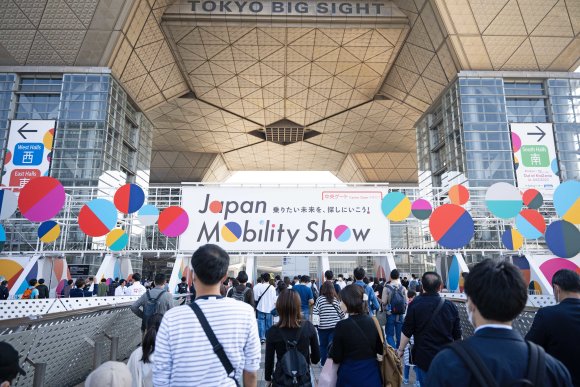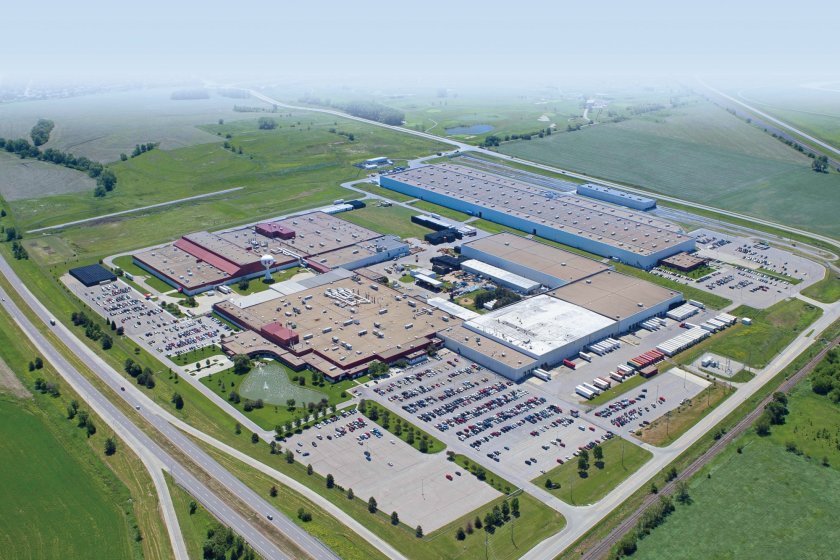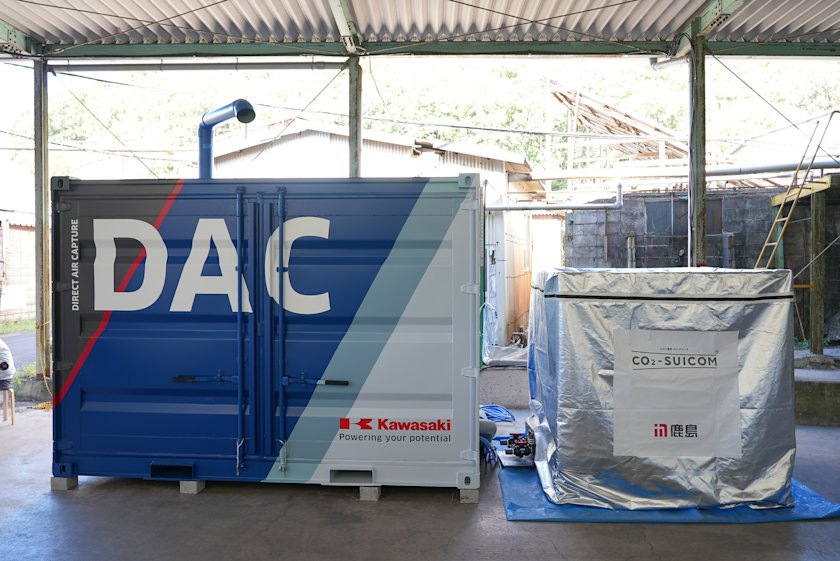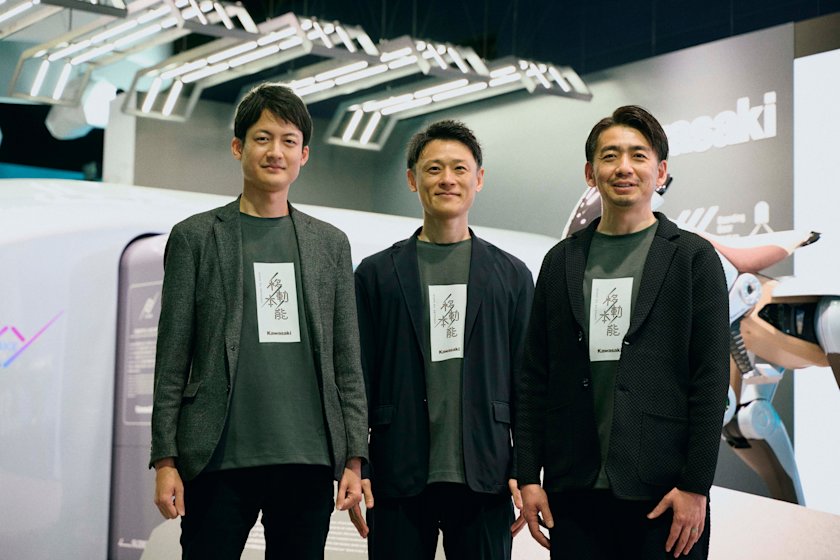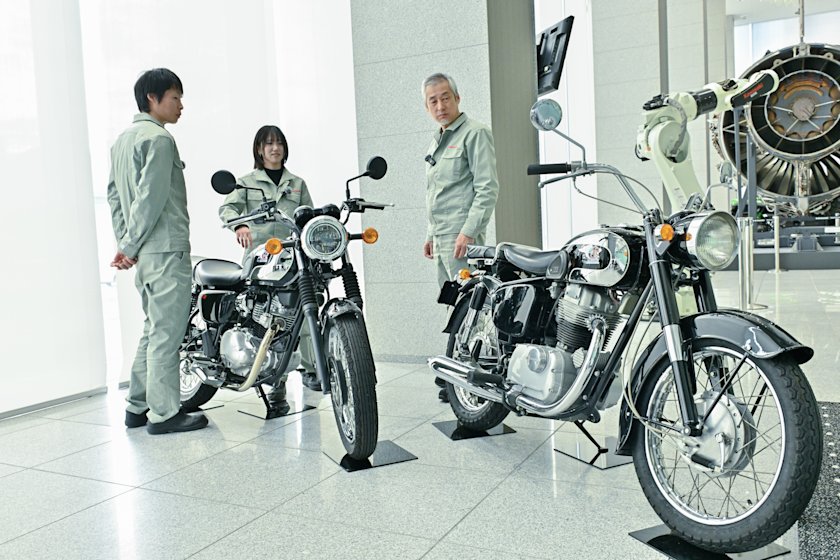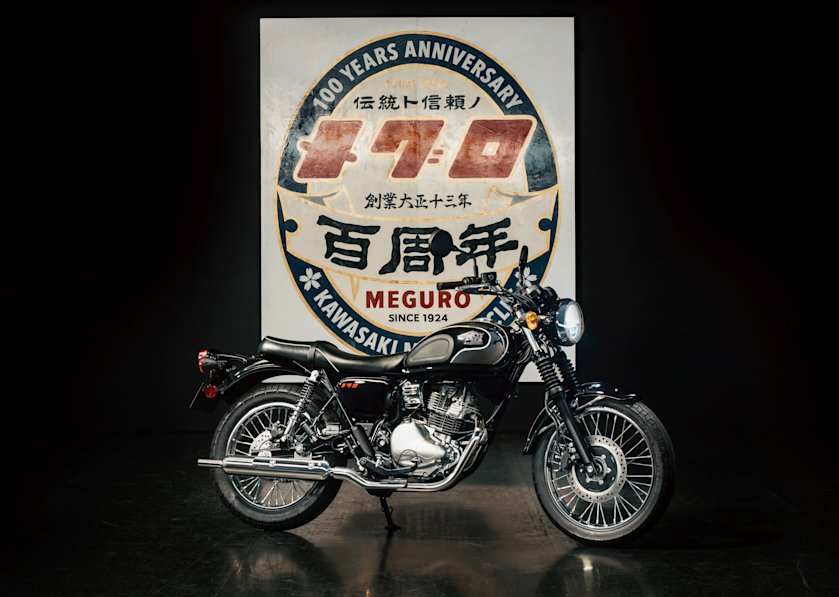Japan Mobility Show 2023, which is the largest mobility show in Japan and is organized by the Japan Automobile Manufacturers Association, opened to the public at Tokyo Big Sight between October 28 and November 5, 2023. Previously known as the “Tokyo Motor Show,” the revamped show was held for the first time in four years with a new theme of: "Discover a future you can’t wait to navigate!" It saw a total of 1.11 million visitors over the nine days and was a major success. In addition to having a Kawasaki Motors booth as in previous years, Kawasaki Heavy Industries Group products—a hydrogen-fueled engine and the unmanned demonstration helicopter K-RACER —were part of a specially organized "Tokyo Future Tour" exhibition. What made Kawasaki’s exhibits truly stand out was its technological culture, where innovative synergistic technologies lead to the creation of further synergies, called simply: “Synergy by Synergy.”
Shifting from a “Motor” to a “Mobility” Show
Kawasaki Motors Booth Represents Heritage and Innovation
The theme of the Kawasaki Motors booth was "Heritage and Innovation.” It showcased past trends in motorcycling and illuminated a direction for the future.
This year marked the 70th anniversary of Kawasaki's motorcycle business, which began in 1953. Looking even further into the past, next year will mark the 100th anniversary of the Meguro Manufacturing Company*1. 2024 is also the 40th anniversary of the birth of the "Ninja" brand.
Making their world premieres at the show were the MEGURO S1 and W230, two single-engine sport models that carry on the legacy of the Meguro brand and the Kawasaki W Series respectively, along with the Ninja ZX-10R and Ninja ZX-4RR in special 40th Anniversary Edition ZXR-inspired colors and graphics, and the KLX230, which features outstanding off-road performance.
In the center of the booth, the TERYX KRX4 1000, an off-road 4-wheeler popular in North America, attracted a lot of attention from visitors.
Nearby, two models making their Japan Premiere highlighted the “Innovation” part of this year’s booth theme. Those included the world's first*2 strong hybrid*3 motorcycle, the Ninja 7 Hybrid, which offers both excellent environmental performance and a character that makes it “Fun to Ride” —a signature fuature of Kawasaki motorcycles. Alongside it was the Ninja e-1 electric motorcycle. As both models represent a new kind of Kawasaki motorcycle for the carbon-neutral era, visitors showed a great deal of interest in the pair.
*1. Meguro Manufacturing Company, founded in 1924 and the creator of Japan's first sport bike brand “Meguro,” merged into Kawasaki Aircraft Industry (now Kawasaki Heavy Industries) in 1964. Since then, the traditions it began have been passed down through the W Series, which became the foundation of Kawasaki’s image as a big-bike manufacturer.
*2. World's first mass-produced strong hybrid motorcycle from a major power sports manufacturer (excluding scooters) as of October 6, 2023, per Kawasaki Motors, Ltd. research.
*3. Strong hybrid systems combine an internal combustion engine (ICE) with an electric motor for powerful riding, and because of their large battery capacity they are able to run on electricity alone.

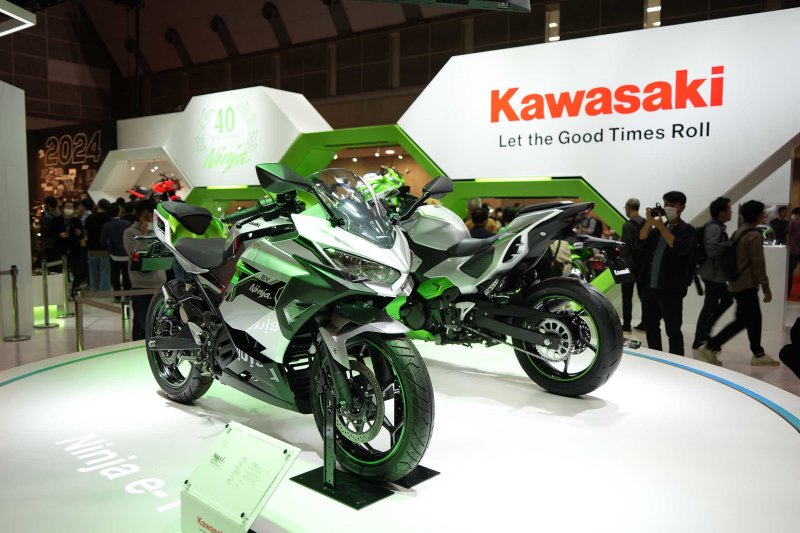
There were several special programs at the show, including the “Tokyo Future Tour,” which featured exhibits highlighting what the future of mobility could look like. The Kawasaki Group exhibited five products in the Life & Mobility area, which offered a glimpse of a world pioneered by next-generation mobility, and in the Emergency & Mobility area, which was a collection of mobility systems able to respond to disasters and similar situations. The products and exhibits intrigued a wide range of visitors to the show.
Hydrogen-Fueled Engines Open Up New Options for a Carbon-Neutral Era
To the question of “What is the major power source for mobility in the carbon neutral era?”, most people would likely answer "electric motors." However, each country in the world has its own energy background, and it is becoming increasingly clear that preparing a variety of options is the shortest way to achieve truly efficient carbon neutrality. An important one of those options is hydrogen-fueled internal combustion engines.
What Kawasaki Motors displayed this time was a hydrogen-fueled engine based on the 998 cm3 supercharged engine in Kawasaki’s flagship Ninja H2.
In May 2023, four motorcycle manufacturers, Suzuki, Honda, Yamaha and Kawasaki Motors established the Hydrogen Small mobility & Engine technology (HySE), a research association. Their goal to provide the world with hydrogen engines as one more option for clean mobility, as it emits almost only water. With the many years of experience and history that these manufactures have in developing internal combustion engines, the effects of adapting these engine technologies to use hydrogen as fuel would be immeasurable.
The HySE-X1 is a 4-wheeled off-road vehicle equipped with a hydrogen engine, that was exhibited by HySE in the motorsports area of the East Wing at the show. The vehicle is set to enter the new “Mission 1000” category of the “Dakar 2024” (Dakar Rally) to be held in Saudi Arabia in January, 2024. Taking on the challenge of what is considered the world's toughest motorsport event, which can promote HySE’s presence and initiatives, led to the acceleration of HySE's development of the core technology for hydrogen engines and the appeal to build global alliances for the realization of compact hydrogen-powered mobility.
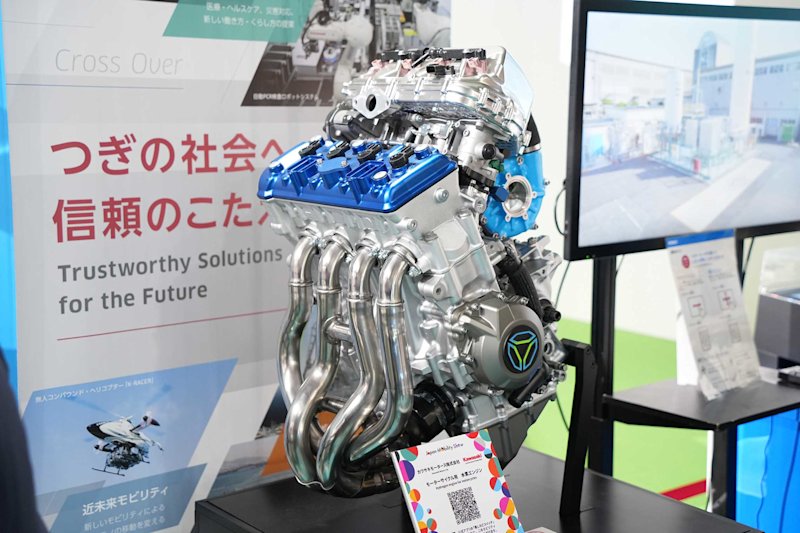
VR Experience Inside Tank of Large-Scale Liquified Hydrogen Carrier
Unveiled at the show was a mock-up model of a large liquefied hydrogen carrier originally developed by Kawasaki.
Large liquefied hydrogen carriers can hold a total of 160,000 m3 of liquefied hydrogen, which is cooled to -253°C and reduced to 1/800th of its initial volume in a gas state, in four large tanks. Both liquefied natural gas (LNG) and liquefied hydrogen generate boil-off gas (BOG) during transport due to heat from external sources, but large liquefied hydrogen carriers incorporate a system to recover the BOG and use it as fuel for the ship's engines.
In LNG liquefaction, natural gas is cooled and stored at -162°C. Kawasaki is taking the knowledge gained in insulation and cooling structures through developing LNG tanks and putting that toward applications in liquefied hydrogen. Hydrogen must be cooled at a temperature 90°C colder than LNG gas. The preliminary design of our large liquefied hydrogen carrier is already complete, and development has moved on to the detailed planning stage as efforts continue toward making technological innovations in producing the large-capacity tanks each required to hold 40,000 m3.
A special highlight of the show was a way for visitors to virtually enter one of the tanks to get a feel for its size and depth through a VR experience. The sheer size of the tank, which measures approximately 40 m from top to bottom, was such that most who saw it in VR could not help but exclaim in surprise.

Superior Industrial Technology Transforming Disaster Response
The Off-Road 4-Wheeler Relied Upon at Disaster Sites
The MULE is an off-road utility vehicle produced by Kawasaki Motors that is popular in the North American market, where it fills a wide variety of roles, from a tough partner for work to a fun way to enjoy the outdoors. It went on sale in Japan in 2022 and has garnered attention for its potential as a mobility solution.
Because MULE models have excellent off-road performance capabilities, the Kawasaki Group is researching how they could be used in applications requiring autonomous driving. If it could be put to use assisting at disaster sites as an unmanned vehicle, such as the concept in the Emergency & Mobility area, it would be extremely helpful and effective. Autonomous driving on rough terrain, unlike driving on paved roads with GPS guidance, presents many hurdles. Nevertheless, development is underway and is currently in the testing stages, with remote control also being examined as a possibility.

K-RACER Explores Potential of Unmanned Logistics in Mountainous Areas
Kawasaki exhibited the K-RACER VTOL unmanned vehicle as one part of our new project to create an unmanned logistics system.
The labor shortage currently being faced in the logistics sector has become a major societal issue, to the extent that it is now referred to as the "2024 problem." In response, Kawasaki is aiming to combine our Robotics, Mobility and Aviation technologies to build a platform for unmanned goods delivery via VTOL unmanned aircraft. This is how the K-RACER came about.
On display at the show was the first prototype to emerge from this platform: the K-RACER-X1. With a rotor diameter of 5 m and an overall height of 1.9 m, it is designed for out-of-sight flight in unpopulated areas and offers a payload of 100 kg. The reason it is a helicopter-type rather than a multicopter (drone)-type is that the former is more suitable for operations at high altitudes.
A second-generation prototype of the K-RACER, the “X2,” has been developed and is playing its role as part of a project with Ina City in Nagano Prefecture, Japan. The “X2” is larger than the “X1”, with a rotor diameter of 7 m and the ability to carry a payload of 200 kg at 0 m above sea level, and to carry a 100 kg payload for over an hour at an altitude of 3,100 m.
The K-RACER is intended to be launched in fiscal year 2026 and is expected to operate mainly in mountainous areas delivering supplies and parts for high-voltage power lines. As the K-RACER is unmanned, it poses less risk than manned helicopters in mountainous areas and it is less affected by weather conditions because it flies along predetermined routes. Being considered for the future is a platform that enables completely unmanned operation, from loading supplies to transport and return.
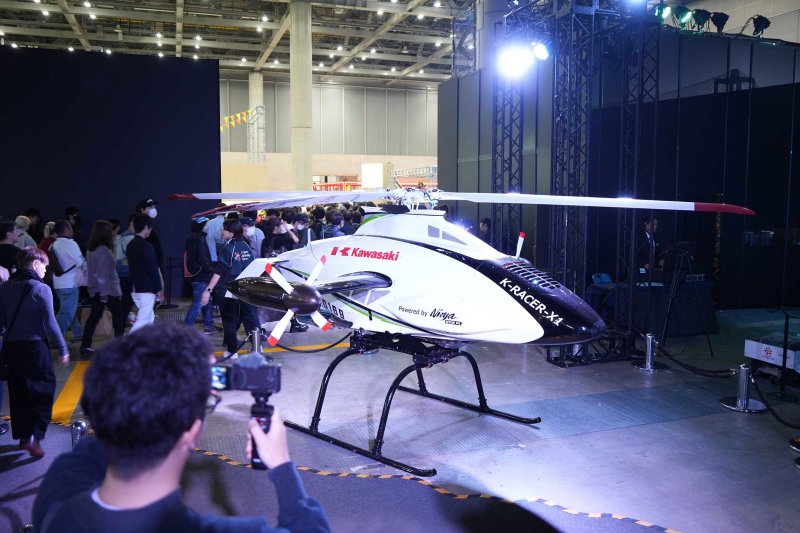

Humanoid Robot Able to Carry Victims to Safety
“Kaleido” is a bipedal humanoid robot that is in development for use in hazardous situations like debris removal from disaster sites and working at high elevations.
Kawasaki was the first company in Japan to commercialize industrial robots. Over the course of many years, we have developed industrial robots that are extremely stable and reliable, and we are now starting to research how to achieve that same stability and reliability with humanoid robots. The development concept is to create a “rubst humanoid platform that will persevere even if it falls down."
Kaleido is 178 cm tall and weighs 85 kg. It can lift up to 60 kg on the bench press, has a built-in battery, uses vision sensors to recognize objects, and has 32 degrees of freedom of articulation in its legs and arms, all of which allow it to perform basic human movements like grasping and carrying.
The electric actuators that move humanoid robots’ joints need to be compact, lightweight, and durable. They must also provide high thrust at low speed when getting up, and low thrust at high speed while walking. The basis of an actuator is its cylinder, and through producing cylinders for construction machinery—specifically industrial robots—Kawasaki have refined our cylinder technology, which is applied in the design of Kaleido’s joints.
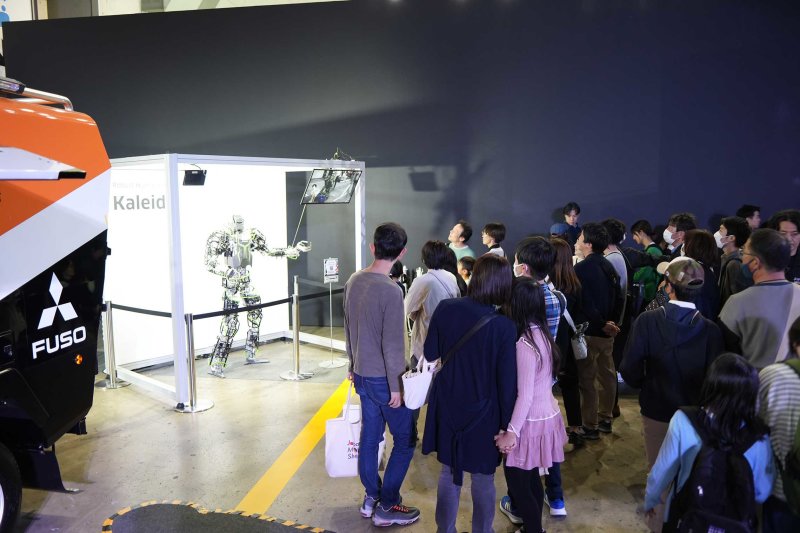
The Kawasaki Ecosystem, Where Innovative Technologies Evolve and Deepen
The way technological breakthroughs in solving societal issues are achieved varies from case to case. But even so, there are very few cases of “creation stories,” where new technologies emerge out of the blue. Rather, new and unexpected technologies often come about as a result of consistent evolution and deepening of already-existing technologies.
A look at the various technological developments of the Kawasaki Group on display at the Japan Mobility Show this year reveals many shared aspects and paints a picture of a group of technologies with the same DNA, like leaves and branches stemming from the same tree trunk. For example, the supercharged engine developed by Kawasaki Motors for the “Ninja H2 Series” in 2014 is being studied for expanded use in many fields, including in the “K-RACER” prototype and in hydrogen engines.
When engineers seek to evolve and deepen underlying technologies, the technologies gain the potential to move beyond simply being underlying. It is often the case that these underlying technologies blend and amalgamate, creating powerful synergies.
Even looking at only a small portion of Kawasaki’s technologies on display at the Japan Mobility Show reveals the synergies present among them. These synergies are not created solely by developing new technology, but rather by expanding applications and furthering technological evolution. In that way, we get the basis of Kawasaki’s ecosystem: "Synergy by Synergy,” where existing synergies create new ones.
Right now, our contributions to the future are steadily beginning to take shape.
